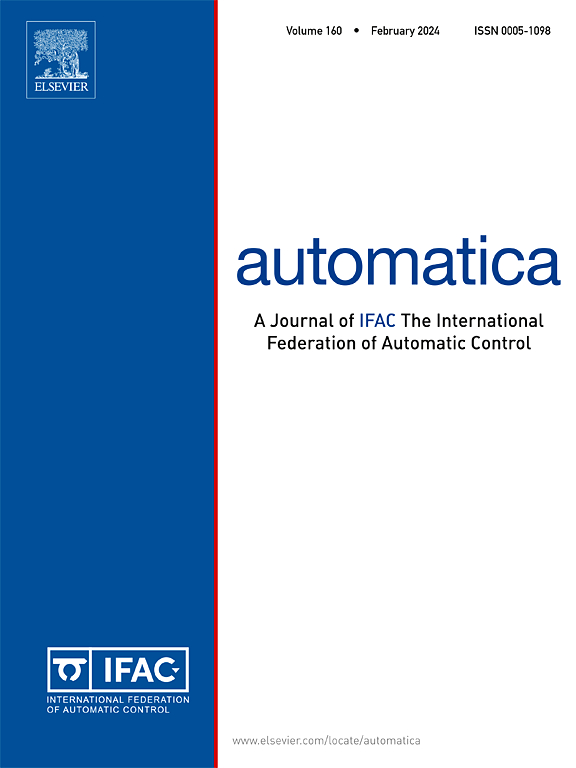状态约束不确定非线性网络物理系统抗欺骗攻击的自适应跟踪控制
IF 5.9
2区 计算机科学
Q1 AUTOMATION & CONTROL SYSTEMS
引用次数: 0
摘要
针对一类具有外源干扰的状态约束非线性网络物理系统(cps)在控制器-执行器(C-A)信道中容易受到欺骗攻击的跟踪控制问题,提出了一种新的自适应跟踪控制方案。与大多数已有的作品不同,这种类型的状态约束具有一个明显的特点,即它发生在控制运行的初始时间瞬间之后的一段时间。设计了误差移位函数和具有变势垒边界的势垒Lyapunov函数(BLF),促进了一种新的自适应跟踪控制方法的发展,该方法不依赖于精确的系统模型,可以同时处理外源扰动和欺骗攻击。特别是,所开发的控制体系结构不仅可以保证所有跟踪误差都进入平衡点的预定义小区域,而且即使不满足初始状态约束,也可以保证闭环系统的总信号在固定时间内符合相应的状态约束。重要的是,跟踪精度是预先已知的,可以通过适当地重组控制设计参数来表示。最后,通过一个具有代表性的应用实例,从理论上验证了所提控制框架的有效性和优越性。本文章由计算机程序翻译,如有差异,请以英文原文为准。
Adaptive tracking control of state-constrained uncertain nonlinear cyber–physical systems against deception attacks
A novel adaptive tracking control scheme is developed to cope with the tracking control issue for a category of state-constrained nonlinear cyber–physical systems (CPSs) with exogenous interferences, which are subject to deception attacks started in controller–actuator (C–A) channel. Different from most existing works, such type of state constraints own a distinct characteristic that they occur some time after the initial time instant of control operation. An error shifting function and a barrier Lyapunov function (BLF) with varying barrier boundaries are designed to promote the development of a novel adaptive tracking control method, which does not depend on the precise system model, and can dispose of the exogenous perturbations and deception attacks simultaneously. In particular, the developed control architecture can not only make sure that all the tracking errors get into a pre-defined small region of the equilibrium point, but also guarantee the total signals of the closed loop system conform to the corresponding state constraints in fixed time even if the initial state constraints are not satisfied. Significantly, the tracking precision degree is known beforehand and could be preseted by restructuring the control design parameters suitably. Eventually, the effectiveness and superiority of the proposed control framework are theoretically authenticated and practically illustrated through a representative application example.
求助全文
通过发布文献求助,成功后即可免费获取论文全文。
去求助
来源期刊

Automatica
工程技术-工程:电子与电气
CiteScore
10.70
自引率
7.80%
发文量
617
审稿时长
5 months
期刊介绍:
Automatica is a leading archival publication in the field of systems and control. The field encompasses today a broad set of areas and topics, and is thriving not only within itself but also in terms of its impact on other fields, such as communications, computers, biology, energy and economics. Since its inception in 1963, Automatica has kept abreast with the evolution of the field over the years, and has emerged as a leading publication driving the trends in the field.
After being founded in 1963, Automatica became a journal of the International Federation of Automatic Control (IFAC) in 1969. It features a characteristic blend of theoretical and applied papers of archival, lasting value, reporting cutting edge research results by authors across the globe. It features articles in distinct categories, including regular, brief and survey papers, technical communiqués, correspondence items, as well as reviews on published books of interest to the readership. It occasionally publishes special issues on emerging new topics or established mature topics of interest to a broad audience.
Automatica solicits original high-quality contributions in all the categories listed above, and in all areas of systems and control interpreted in a broad sense and evolving constantly. They may be submitted directly to a subject editor or to the Editor-in-Chief if not sure about the subject area. Editorial procedures in place assure careful, fair, and prompt handling of all submitted articles. Accepted papers appear in the journal in the shortest time feasible given production time constraints.
 求助内容:
求助内容: 应助结果提醒方式:
应助结果提醒方式:


